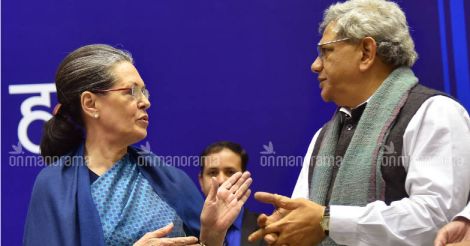The rejection of the Yechury line by the Communist Party of India (Marxist) (CPM) central committee is on expected lines, given the domination of the Karat group in the decision making process of the party.
The Congress does not seem overtly worried about the CPM's decision to go with the left parties in Bengal during the Lok Sabha elections.
Even within the CPM, the pro-alliance group from Bengal has not shown signs of an uprising against the central committee decision.
Sitaram Yechury's re-election as general secretary of the CPM hangs in the balance and a final decision on poll alliances would emerge only at the party congress in Hyderabad later this year.
There is consensus in political circles that Bengal, with its 42 Lok Sabha seats, would see a multi-cornered contest between the Trinamool Congress, the CPM, the Congress and the Bharatiya Janata Party (BJP), unless Mamata Banerjee opts for a last minute tie-up with the Congress.
Interestingly several states could see multi-polar contests in the 2019 elections, despite the clamor for a common opposition front against the BJP.
During the tenure of Sonia Gandhi as the Congress boss, the party had entrusted A K Antony and senior leaders to work out partnerships with regional parties.
The main achievement of this committee was the formation of the Grand Alliance in the Bihar assembly polls in 2015, which brought together the Janata Dal (U), the Rashtriya Janata Dal (RJD) and the Congress on a common platform to take on the BJP.
The alliance swept the polls, but Nitish Kumar-led JD(U) later returned to the NDA fold, taking the state government with it.
Despite this Bihar would still see a National Democratic Alliance (NDA) versus United Progressive Alliance (UPA) contest as the Congress is fully supportive of RJD supremo Lalu Prasad, who is a prominent voice against Narendra Modi and Amit Shah.
In many other states, there is uncertainty in the opposition ranks that gives the the BJP an edge.
In Uttar Pradesh, where the Congress had an alliance with the Samajwadi Party (SP), several factors including the virulent opposition of the party supremo Mulayam Singh Yadav and his bitter acrimony with his son and then chief minister Akhilesh Yadav, wreaked the partnership.
The Samajwadi Party cadres did not work for the Congress candidates, preferring the BJP candidates in several constituencies.
The situation in UP, the country's largest state which elects 80 members of parliament, is still fluid. It is likely to see a multi-cornered contest between BJP, Mayawati's Bahujan Samaj Party, the Samajwadi Party and the Congress.
There are not many takers yet for a grand alliance of the BSP, the SP and the Congress against a dominant BJP led by Chief Minister Adityanath.
The second largest electoral state in the country, Maharashtra, which sends 48 MPs - had seen a four-cornered contest between the BJP, the Shiv Sena, the Congress and the Nationalist Congress Party (NCP) in the 2015 assembly elections, which worked to the BJP's advantage.
Though there is no formal announcement of an alliance yet, NCP president Sharad Pawar has said that he is not averse to working with the Congress and the two parties have taken on the Devendra Fadnavis government on the agrarian crisis in the state.
On the other hand, Shiv Sena, too, has toned down after the BJP desisted from opposing the Shiv Sena taking control of the Mumbai Municipal Corporation.
Another large state is Tamil Nadu with its 39 MPs. The political situation there too is complex with the ruling AIADMK divided into factions, and two film stars launching their own parties, not to speak of Vijayakanth, who has broken up with the BJP.
Though technically the DMK and the Congress are said to be together, Narendra Modi's visit to DMK patriarch M Karunanidhi showed that the BJP is trying to reach out to all parties in a state, where it has electable presence in small pockets.
Unlike Sonia Gandhi, who interacted regularly with opposition leaders inside and outside Parliament, incumbent Congress president Rahul Gandhi has remained focused on the party organization and on electoral battles where the party is directly taking on the BJP .
After Gujarat, the Congress is gearing up for large states like Karnataka, Madhya Pradesh, Rajasthan and Chattisgarh, where the saffron outfit is its only opponent.
Thus the internal debates of the CPM have not roused much interest in the Congress.
There is also no indication on whom Rahul will designate to deal with the opposition parties for pre-poll alliances and whether he wants to revive the UPA strongly before the elections, or go for state-by-state alliances.
There is a feeling in the Congress that it can also do business with Mamata Banerjee, if she comes up with good numbers in a hung parliament.
Read more | Reel charm in realpolitik: will the Rajini magic work?

























 CPM general secretary Sitaram Yechury had earlier announced his willingness to resign from the post after his bid for an alliance was defeated.
CPM general secretary Sitaram Yechury had earlier announced his willingness to resign from the post after his bid for an alliance was defeated.